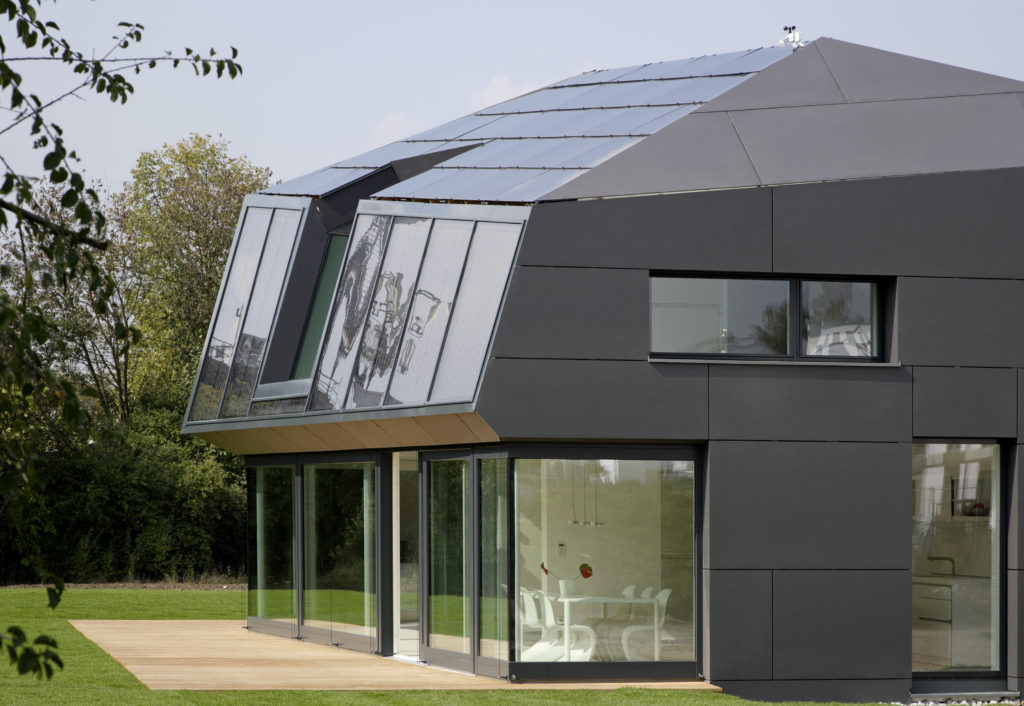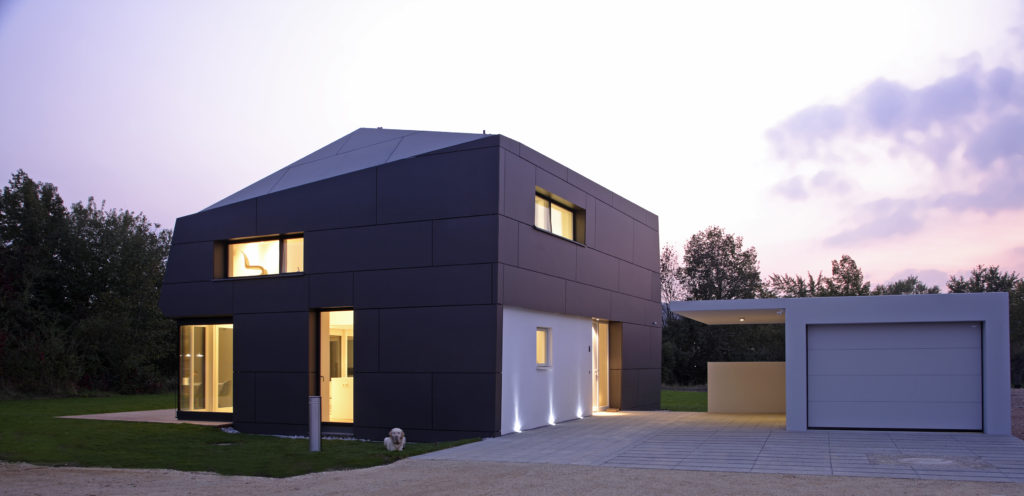House of the Future
In order to optimise and verify the energy concept, static calculations and dynamic simulations were performed by the Frauenhofer Institute for Solar Energy Systems.
With a calculated thermal energy demand of around 25 kWh/m²a, the building is a bit over the limit values of a passive house. This is due first and foremost to the generous glazed surfaces on the ground floor of the building. The solar thermal-run heat pump covers the thermal energy demand and tap water heating. The solar thermal system here has a gross collector area of approx. 35m². In total, the system achieves solar coverage of around 40%.
For a four member family, household electricity consumption of 2000 kWh/a was assumed, corresponding to modern furnishing with energy-efficient appliances. If we balance the annual energy demand (power) of the building from use and building services with the renewable energy produced from the photovoltaic system, this results in a positive balance of energy.
The power required by the heat pump to generate heat is renewable power which the 55 m² photovoltaic system generates and feeds into the grid. In the annual balance, the PV system covers the power requirements of all the building services and household and thus results in an energy surplus.
A compact EIB-controlled building service system regulates the passive use of solar energy from the south and west in winter and automatically shades the southern surface of the glass during the summer. In order to avoid making the system overly technical and to make it possible for the homeowner to choose a more conventional lifestyle, the automatic regulation system can be turned off. The mechanical cross ventilation and the natural ventilation from the lower level up to the roof ensures optimal air exchange and provides for well-being.
Solar energy production can also have its dark side. Therefore, with all solar optimisations, the utmost importance was attached to summertime protection from heat so as to ensure a pleasant indoor temperature during the summer, too.
Different types of sun protection and night-time cooling of the building were tested in dynamic simulation calculations. The results show that a system with an additional night-time natural ventilation system will fully satisfy the criteria pursuant to DIN 4108-2:2003-07.
Finally, the fully-automatic sun protection and natural ventilation are actuated by an intelligent control system with sensors to measure temperature, CO2 and humidity in connection with a weather station. This intelligent control system ensures that the inhabitants’ needs with regard to well-being, comfort and indoor environment will be met.
The building comprises 175m² of living space plus a 66 m² basement and a garage. It is handicapped accessible including wheelchair accessible passages to the outside in order to enable flexible use and maximum freedom of movement. The house is designed to suit people’s needs so that the occupants feel comfortable. For this reason there are large wide-opening parallel sliding doors even though these are not actually energy-efficient. Complete glazing of the open rooms in which the most time is spent – living, cooking and eating – fuses interior and exterior together. On the upper floor, the polygonal crystalline building form can be experienced spatially in three dimensions with windows and ceilings inclined at different angles.
The crystal theme continues throughout the entire building and is enhanced by the fact that the roof and outside walls are coated with the same anthracite-coloured material. The diamond-shaped solar thermal and photovoltaic panels alternate at sharp angles with bonded fibre cement tiles and all panels are flush. The anthracite-coloured cladding sheets pick up on the visual of the solar collectors, making the wall and roof form an optical unit. The edges fuse together and the building as a whole is reminiscent of a crystal glistening in blue-grey.
In contrast to this, the interior spaces should be bright and cheerful. A whitish limestone floor from the region on the ground floor, a bright wood floor upstairs and white-glazed ceilings make up the material concept for the interior.
Three theses for living in the future
It all started with the question of what a future without a need for fossil fuels in architectural structures would be like. The target is a house designed for the future, which will set the building standards for 2020. Besides passive house technology, a new, more highly developed building concept will lead the way into the future. This building concept is not only based on energy efficiency, but, more importantly, on solar energy production. From these basic requirements emerged three main theses for living in the future:
1. The place where a person lives should be a good fit for that person. The modern way of life changes very quickly. Therefore, the rooms should be able to be easily altered in order to fulfil new needs of the homeowner. The house should be comfortable, low maintenance, and a place of tranquillity in this increasingly fast-paced world.
2. The building services engineering, control system, and construction should mesh with the architecture of the house to create one homogenous unit. The buildings should offer a high degree of flexibility so that the latest technology can be integrated at any time.
3. Energy: High energy efficiency must be achieved—the house itself should produce all of the energy it needs. The house is designed with environmentally compatible materials and functions in an ecologically sustainable way by conserving resources and using a nominal amount primary energy.
The task of the Regensburg architectural firm “fabi” was to incorporate these various demands, creating a harmonious whole. The planning focus here is placed not only on the technology, but rather first and foremost on the user.





